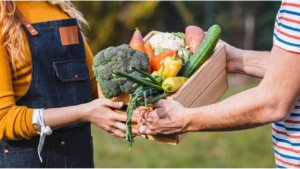I was once dressed down by a feisty dairy farmer for saying that I don’t think we should define regenerative agriculture. I get her point. Regenerative agriculture is hard enough for farmers to understand and adopt. Surely we need a clear industry standard agreed definition?
Ethan Soloviev says it like this;
‘’It’s important to start with this: Regenerative Agriculture cannot be defined. What does Regenerative Agriculture aim to regenerate?: The health, vitality, and evolutionary capability of whole living systems.
In this context, why is it inappropriate to “define” what regenerative agriculture “is”?
“Define” literally means, “bring to an end.” It comes from the Latin verb, definire, composed of de- “completely” + finire “to bound, limit,” from finis, “boundary, end.” This is the opposite of regeneration. Confining the subject to a single “ending or limit” would be antithetical to the processes that our discipline seeks to bring into agriculture.
Insisting on a single definition would put a wall around our agricultural landscapes, separating them from the natural world. This is the impact of modern, chemical ‘clean cultivation’ techniques that can remove all traces of living, biodiverse habitats or possible natural volatility from the fields where our food grows.
Regenerative Agriculture calmly cracks and composts these walls in our landscapes and ultimately in our minds. Each community of practitioners in each bioregion of the world has the opportunity to re-generate the ecocultural meaning of “Regenerative Agriculture.” They will do so in a way that is unique to their place, history and whole living ecosystem’’.

I agree wholeheartedly.
For me regenerative agriculture is more than simply a set of practices, it’s a paradigm.
The regenerative paradigm has emerged in response to the ‘poly crisis’ humans have brought upon themselves and our planet. It is not some new thing, it’s the next evolution – albeit a very big leap – in agriculture.
Regenerative agriculture is built on the foundations of the best of all the stages of agriculture that have gone before starting with indigenous farming and transcending and including locally adapted mixed farming practices, the best of the learnings from the green revolution, and firmly stands on the shoulders of organic farming practices and localised food systems.
New paradigms emerge when people and communities are ready, and this paradigm has organically emerged in different parts of the world with the language and cultural flavour that reflects the people and place. These are the lineages. The different lineages of regenerative agriculture should sound and be described differently – that’s the point. Regenerative agriculture is an agroecological approach – it takes the principles of nature and applies them to the production of food and farming in a way that is adapted to people and place. Nature works everywhere but it looks very different in every different part of the world.

I totally understand the pushback to not wanting to define regenerative agriculture. Surely the big corporations will start calling everything ‘regenerative’ – the word will become meaningless – utterly greenwashed? For a few moments this morning, after watching Bayer Crop Science China’s press release launching their new ‘regenerative farming’ campaign I might have agreed!!! However, in a calmer moment, I remember that regenerative farming is a living systems approach and requires a living systems paradigm in which to be adopted and rolled out.
What is happening here is that the big players – those who have been the most successful in our mechanistic 20th century dominate, command and control paradigm – want the physical benefits of regenerative agriculture but want to adopt it within their existing highly efficient organised machine.

Let’s say a small farmer is quietly regenerating their land and selling amazing healthy food to their local community and can show their customers how they are regenerating their land. Why on earth should they not be allowed to call their product regenerative?
The call for a universal definition, standardisation and set of best practices for regenerative agriculture is because we rely upon globalised food chains and convenient supermarkets. These people want assurance that their food grown halfway around the world is ‘really’ regenerative.
I agree that there will probably always be a need to produce some food in this way and for this food it is important to measure and communicate regenerative outcomes. Regenerative outcomes, such as soil carbon sequestration, improved biodiversity, enhanced water cycles and the improved lives of farmers are something that are easier to more universally agree upon for foods that enter long and often anonymous supply chains. I agree there does need to be significant rigour around what outcomes are measured and the methodologies used. And I suggest this is not decided upon by the ‘big food’ industry themselves, otherwise it’s a lot like putting the fox in charge of guarding the hen house!
By focusing on measuring the regenerative outcomes we can get less hung up about trying to fit farmers into a tick box compliance exercise based on a defined levers of do’s and don’ts.

The regenerative paradigm isn’t just emerging in farming, it’s happening in all areas of life. There are regenerative citizens, regenerative developments, regenerative business models, regenerative economics and regenerative leaders. There’s a new Re-Generation of people stepping up and putting life at the centre of every act and every decision.
A recent update of the planetary boundaries framework finds that six of the nine boundaries are transgressed, suggesting that Earth is now well outside of the safe operating space for humanity. We have created patterns of living and organising society that are out of alignment with how our planet works.
Daniel Christian Wahl;
Regeneration is understanding that the universe is benevolent, not out to get us, life is evolving towards higher expression of complexity, diversity, vitality and abundance and has so for 3.8 billion years. It’s a blip that we tend to call history where one species decided to take on practices like agriculture and then, with the scientific revolution, very recently lots of powerful technologies that allowed us to create the fantasy that somehow we stand above all of that – that is a biophysical nonsense of upmost dimensions. We need to become real again and understand that the only way to have a humane future is within the limits of a living planet as a living planet.
.
If we want a healthy planet that can support future generations of humans then we need to move beyond farmers being the only ones expected to be regenerative!
May I politely suggest that we all consider applying regenerative principles to our own life and work? Let’s take responsibility for buying what you know is regenerative by finding a local farmer doing amazing ecologically enhancing things and asking them how they are regenerating their land. Or using a company like Primal Meats who connects you with these farmers.
A regenerative society should not be relying upon long fragile global supply chains. ‘Out of sight out of relationship’ is one of the reasons we are in this mess in the first place!
I believe it is not for regenerative agriculture to fit into man-made mechanistic thinking and systems, it’s for humans to evolve their thinking so they can align with nature and use living systems as a model to design our lives, our society and how we grow our food.
Caroline Grindrod
